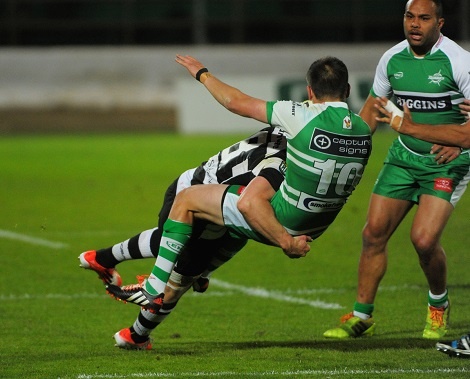- Rugby Toolbox
- Referees
- Referee Development
- Law Questions and Answers
- Law 14 Tackle
- Law 1 The Ground
- Law 3 Team
- Law 4 Player's Clothing
- Law 5 Time
- Law 6 Match Officials
- Law 7 Advantage
- Law 8 Scoring
- Law 9 Foul Play
- Law 10 Offside and Onside in Open Play
- Law 11 Knock-on or Forward Pass
- Law 12 Kick-off and Restart Kicks
- Law 13 Players on the Ground in Open Play
- Law 14 Tackle
- Law 15 Ruck
- Law 16 Maul
- Law 17 Mark
- Law 18 Touch, Quick Throw and Lineout
- Law 19 Scrum
- Law 20 Penalty and Free Kick
- Law 21 In-Goal
Law 14 Tackle

Law 14 Tackle
1. What is the principle of the tackle?
Answer: It can take place anywhere in the field of play and the actions of the players involved must ensure a fair contest and allow the ball to be available for play immediately.
Requirements For A Tackle
1. For a tackle to occur what must happen to the ball carrier?
Answer: The ball carrier must be held and brought to ground by one or more opponents.
2. What does being brought to ground in a tackle mean?
Answer: The ball carrier is lying, sitting or has at least one knee on the ground or on another player on the ground.
3. What does being held in the tackle mean?
Answer: The tackler must continue holding the ball carrier until the ball carrier is on the ground.
Players In The Tackle
1. Who are the players in a tackle?
Answer: A. the tackled player, B. the tackler(s), C. others including (i). player(s) who hold the ball carrier during a tackle but do not go to ground, (ii). player(s) who arrive to contest possession in the tackle, (iii). player(s) who are already on the ground.
Player Responsibilities
1. What must tacklers do?
Answer: A. immediately release the ball and ball carrier after both players go to ground, B. immediately move away from the tackled player and get up, C. be on their feet when attempting to play the ball, D. allow the tackled player to release the ball, E. allow the tackled player to move away from the ball.
Sanction: PK
2. How may tacklers play the ball?
Answer: From the direction of their own goal line provided they have complied with their other responsibilities and a ruck has not formed.
3. What must tackled players do?
Answer: A. make the ball available by releasing, passing or pushing the ball in any direction except forward, and placing the ball in any direction, B. move away from the ball or get up, C. not lie on or over the ball preventing opponents from gaining possession of it.
Sanction: PK
4. What must other players at a tackle other than the tackler(s) and tackled player do?
Answer: A. remain on their feet and release the ball and ball carrier immediately, B. remain on their feet when they play the ball, C. arrive at the tackle from the direction of their own goal-line, D. not play the ball or attempt to tackle an opponent while on the ground near the tackle.
Sanction: PK
5. Any player who gains possession of the ball at a tackle must to what?
Answer: A. play the ball immediately by moving away or by passing or kicking it, B. remain on their feet and not go to ground at or near the tackle unless tackled, C. may be tackled provided the tackler does so from the direction of their own goal-line.
Sanction: PK
6. How are offside lines created at a tackle and where are they?
Answer: When at least one player is on their feet and over the ball which is on the ground – each team’s offside line runs parallel to the goal line through the hindmost foot of any player in the tackle or on their feet over the ball; if that point is behind the goal-line, the goal-line for that team is the offside line.
7. When does a tackle end?
Answer: A. a ruck is formed, B. a player on their feet from either team gains possession of the ball and moves away or passes or kicks the ball, C. the ball leaves the tackle area, D. the ball is unplayable where by a scrum is formed with the team moving forward to throw the ball in and if no team was moving forward, the attacking team throws the ball in.